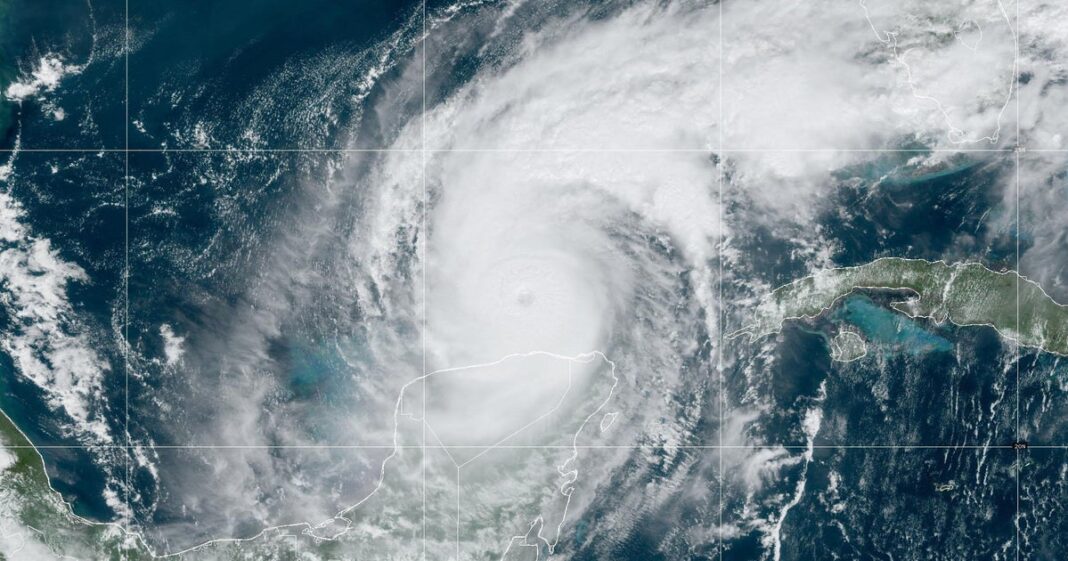Ten days before start of the 2025 Atlantic hurricane season, officials at the National Oceanic and Atmospheric Administration announced their forecast for how many tropical storms and hurricanes to expect this year. The current outlook predicts a 60% chance of an “above-normal” hurricane season, with between 13 to 19 named storms. Six to 10 of those are expected to strengthen into hurricanes, and three to five could become major hurricanes, forecasters said.
They estimated there’s a 30% chance of a “near-normal” season and a 10% chance of a “below-normal” season.
NOAA, the federal agency in charge of weather and climate predictions, releases its seasonal hurricane outlook each spring. It incorporates research from the Climate Prediction Center, the National Hurricane Center and the National Weather Service, all branches of the agency.
Acting NOAA administrator Laura Grimm and National Weather Service director Ken Graham presented the findings during a news conference Thursday morning at the Jefferson Parish Emergency Operations Center in Gretna, Louisiana, just outside of New Orleans. They chose that location to commemorate the victims and destruction of Hurricane Katrina, 20 years after that storm devastated the area.
In their remarks, Grimm and Graham each emphasized the technological developments that have allowed NOAA and the weather service to produce forecasts that are more accurate with each passing year.
“The United States is fortunate to have the worlds best scientists, meteorologists and computer modeling experts,” said Grimm. “These experts are constantly learning from current and past events.”
The Atlantic hurricane season officially runs from June 1 until November 30, with peak activity typically occurring between mid-August and mid-October.
An average season produces 14 named storms, including seven that develop into hurricanes. Three of those, on average, become major hurricanes, meaning a Category 3 or higher on the Saffir-Simpson scale, with sustained wind speeds of at least 111 miles per hour. Category 5, the top of the scale, brings wind speeds of at least 157 mph.
CBS News
Every Atlantic hurricane season since 2015 has produced more storms than the “average” — a standard based on annual hurricane activity recorded over the period from 1990 to 2020 — although four seasons since then have produced two or three major hurricanes, either below or on par with the 30-year norm.
According to forecasters, there are a “confluence of factors” influencing the number of storms that materialize over the course of the season. A significant one in 2025 is the neutral phase of the El Niño-Southern Oscillation, or ENSO, cycle, which often plays a substantial role in the intensity of tropical activity in the Atlantic.
Warmer than average ocean temperatures and weak wind shear in the forecast may also lead to a more active season, the outlook said, as could the potential for higher storm activity from the West African Monsoon, the weather system from which most Atlantic hurricanes originate.
Some seasons are more active than others, and hurricanes at times can occur outside of the designated six-month window. Science has shown in recent years that climate change is contributing to the intensity of these storms, which are fueled by warmer waters. Researchers are continuing to explore connections between rising temperatures and more destructive tropical weather.
Because each year is different, NOAA’s hurricane forecast provides a framework for communities in storm-prone areas to prepare for the season ahead. The agency may also release an updated hurricane forecast later in the season should their assessment change.
NOAA’s forecasting model, the Hurricane Analysis and Forecast System or HAFS, is expected to undergo an upgrade that officials believe could increase the accuracy of storm tracking by about 5%.
“In my 30 years at the National Weather Service, we’ve never had more advanced models and warning systems in place to monitor the weather,” said Graham in a statement. “This outlook is a call to action: be prepared. Take proactive steps now to make a plan and gather supplies to ensure you’re ready before a storm threatens.”
Last year, NOAA predicted an above-average number of storms, with between 8 and 13 hurricanes. The 2024 season ended up producing 11 hurricanes, five of which strengthened into major hurricanes. Five hurricanes made landfall in the continental U.S., including two — Helene and Milton — that hit as major hurricanes.
Grimm said last year’s forecast “was right on the money,” within NOAA’s predicted range.
Threat of an above-average hurricane season
When researchers from Colorado State University’s Tropical Cyclones, Radar, Atmospheric Modeling and Software team published their annual forecast earlier this spring, they also predicted an above-average hurricane season for 2025, likely producing stronger and more frequent storms than a typical year but fewer than last season.
Their predictions have tended to more or less align with those released by NOAA. Levi Silvers, who leads the research team at Colorado State, told CBS News in April that their predictions are “fundamentally dependent on the observations that NOAA collects all around the globe,” especially in the oceans, so they generally reach similar conclusions.
Silvers and his team predicted there would be 17 named storms this season — tropical storms with sustained wind speeds of at least 39 mph. According to their forecast, nine of the storms will grow into hurricanes, with three developing into major hurricanes. That would place hurricane activity at roughly 125% of the seasonal average recorded between 1991 and 2020, according to their report.
“It’s a noticeable and important difference, because it matters for people along the coastlines whenever we have an above average season,” Silvers said at the time.
The Colorado State report largely attributed the higher activity expected this year to warm sea surface temperatures, which can essentially act as fuel for storms. But the findings also pointed to “considerable uncertainty” as to which phase of the ENSO cycle would coincide with the coming hurricane season.
El Niño, the warmer half of the cycle, is often linked to conditions in a section of the equatorial Pacific that disfavor hurricanes, while La Niña, the colder inverse, is considered more conducive to hurricane formation. La Niña conditions ended shortly after CSU released its hurricane forecast and returned to “neutral,” a state that researchers said could be favorable for hurricanes to develop in the absence of El Niño.


